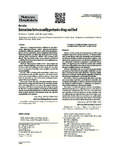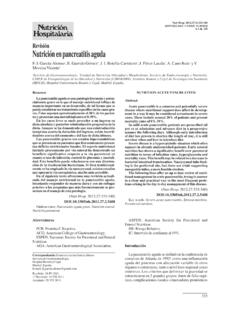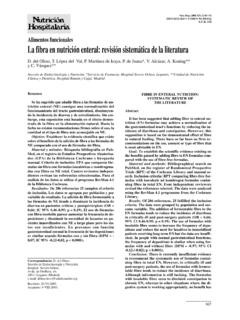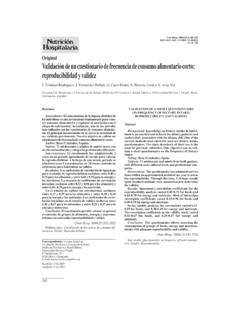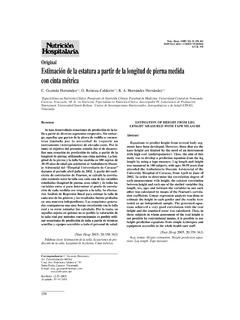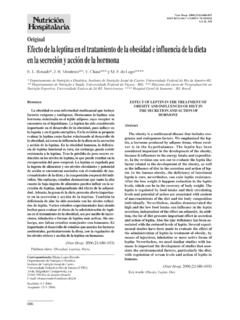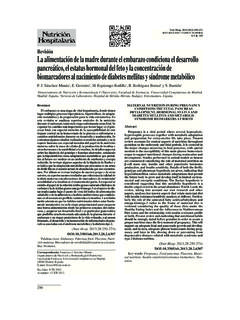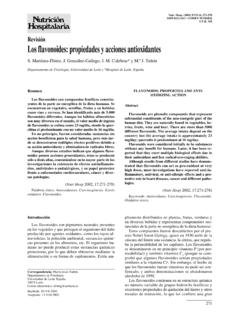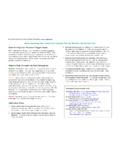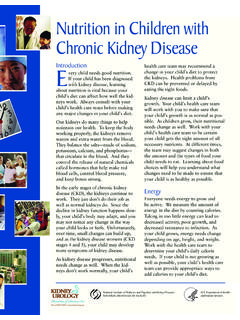Transcription of Energy expenditure: components and evaluation …
1 430A. C. Pinheiro Volp et Hosp. 2011;26(3):430-440 Nutr Hosp. 2011;26(3):430-440 ISSN 0212-1611 CODEN 318 Revisi nEnergy expenditure : components and evaluation methods A. C. Pinheiro Volp1, F. C. Esteves de Oliveira2, R. Duarte Moreira Alves3, E. A. Esteves4y J. Bressan51 Assistant Professor. Nutrition School. Federal University of Ouro Preto. Minas Gerais. Brazil. 2 Candidate for Doctoraldegree in Food Science and Technology. Federal University of Vi osa. Minas Gerais. Brazil. 3 Candidate for Doctoral degreein Nutrition Science.
2 Federal University of Vi osa. Minas Gerais. Brazil. 4 Assistant Professor. Department of University of Vales do Jequitinhonha and Mucuri. Minas Gerais. Brazil. 5 Associated professor. Nutrition and HealthDepartment. Federal University of Vi osa. Minas Gerais. ENERG TICO: COMPONENTESY M TODOS DE EVALUACI NResumenIntroducci n:Determinar el gasto energ tico (GE),considerando la actividad f sica y el estado de salud, esmuy importante para ajustar el c lculo de la necesidadnutricional para cada individuo. Para eso, se pueden utili-zar t cnicas como la calorimetr a indirecta, la bioimpe-dancia el ctrica, el agua doblemente marcada, las ecua-ciones predictivas, entre otras.
3 Estos m todos sonutilizados en la pr ctica cl nica y en estudios cient embargo, debido a la inconsistencia de los resultadosde estas investigaciones, todav a no hay un consenso res-pecto a su :De esa forma, esta revisi n tiene como obje-tivo discutir los componentes del gasto energ tico, as como las t cnicas para su determinaci n y estimativa,se alando sus ventajas y limitaciones. Resultados y discusi n:La calorimetria indirecta y elagua doblemente marcada son m todos considerados m sacurados, sin embargo onerosos.
4 Los otros m todos pre-sentan limitaciones, pero por su practicidad y bajo coste,algunos de ellos pueden ser usados con cautela.(Nutr Hosp. 2011;26:430-440) clave: Metabolismo energ tico. Gasto energ cal rica. M todos. :The determination of Energy expendi-ture, considering the physical activity level and healthstatus, is very important to adjust the individuals nutri-tional supply. Energy expenditure can be determined byusing indirect calorimetry, bioelectrical impedance, dou-bly labeled water, predictive equations, among others.
5 Allthese methods have been used in clinical and researchareas. However, considering the inconsistence in severalresearch results, there is no consensus yet about theapplicability of many of these methods. Objectives:The aim of this review is to describe thecomponents of Energy expenditure and the methods forits determination and estimation, summarizing theirmain advantages and limitations. Results and discussion:Indirect calorimetry and dou-bly labeled water are considered more accurate methods,but expensive.
6 On the other hand, even though othermethods present limitations, they are convenient and lessexpensive, and can be used with some caution.(Nutr Hosp. 2011;26:430-440) words: Energy metabolism. Energy expenditure . Caloricintake. Methods. : : Age (years).ATP: Adenosine triphosphate. BEE: Basal Energy : Bioelectrical Impedance : Body Mass : Body weight (kg).CIC: Circulatory indirect : Carbon : Direct : Diet-induced : Doubly labeled water. EE: Energy expenditure . EER: Estimated Energy Requirement. H: Height (m).
7 H: : Deuterium. IC: Indirect : Ana Carolina Pinheiro do Cruzeiro, BOX: 35400-000 Ouro Preto, MG. : : expenditure431 Nutr Hosp. 2011;26(3):430-440 ICU: Intensive care : : : : Square : Metabolic equivalents. Min: : : Oxygen-18. O2: : Physical : Physical activity : Resting Energy : Indirect : Total Energy : Weight (m).IntroductionThe Energy that human body requires to maintain itsorganic and vital functions is obtained by the oxidationof macronutrients from expenditure (EE) can be considered a process of Energy productionfrom Energy substrates (carbohydrates, lipids, proteinsand alcohol) combustion, in which there is an oxygenconsumption (O2) and carbon dioxide production(CO2).
8 Part of this chemical Energy is lost as heat and inurine, and the remain Energy is stored in high-energymolecules known as adenosine triphosphates (ATPs).2 Total Energy expenditure (TEE) is the Energy requiredby the organism daily and it is determined by the sum of 3components: basal Energy expenditure (BEE), diet-induced thermogenesis (DIT) and physical activity (PA).3 There are several methods for EE measurementsuch asindirect calorimetry (IC) and direct calorimetry (DC),bioelectrical impedance (BIA), doubly labeled water(DLW), predictive equations, and ,5 The EE deter-mination is important to adjust the individuals nutri-tional offer, and must consider the demand of Energy forphysical activity and specific health conditions.
9 Most ofthese methods have been widely used in human studiesfor different clinical applications (enteral and parenteralnutrition, obesity and others). However, there is no con-sensus about the applicability of some of them due to dif-ferent results from literature. Therefore, this reviewdescribes the Energy expenditure components as well asdiscusses several methods for Energy expenditure esti-mation, emphasizing their advantages and limitations. MethodsThis review was performed using a variety of medicaland scientific databases including Medline, PubMed,Scielo, and Lilacsto identify relevant articles focused onenergy expenditure measurement methods.
10 The follow-ing key words, in English, Spanish and Portuguese wereused: indirect calorimetry, Energy expenditure , bioelec-trical impedance, doubly labeled water, predictive equa-tions, circulatory indirect calorimetry, food intake mea-surement, portable Armandand physical activity ques-tionnaire. Articles were selected after an abstractpre-reading and independently of their publication year,since we were interested in articles which described orig-inal methodologies for measuring Energy of Total Energy expenditure (TEE)Basal Energy expenditure (BEE)
